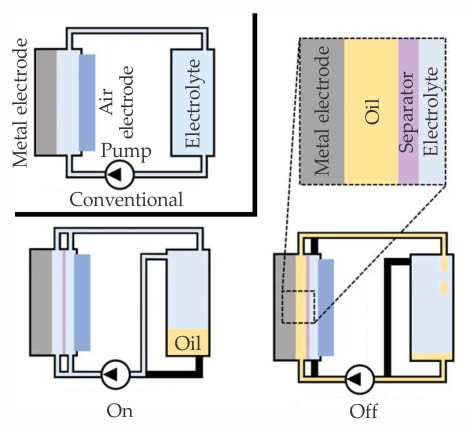
An aluminum–air battery sandwiches a circulating aqueous electrode between an aluminum anode and a cathode in contact with ambient air. When the battery is connected to an external circuit, two electrochemical reactions take place: At the anode, aluminum reacts with hydroxide ions in the electrolyte to liberate electrons; at the cathode, oxygen from ambient air reacts with water and with the electrons reaching the cathode to form hydroxide ions. Since the aluminum is consumed, the battery can’t be recharged. Still, Al–air batteries offer an appealing combination of light weight, low cost, and high energy density. But they face a major limitation: When they’re not in use, the electrolyte corrodes the aluminum anodes. In a month the batteries can irreversibly lose as much as 80% of their charge, compared with 5% losses for lithium-ion batteries. Various strategies have been devised to reduce the corrosion and extend the battery shelf life, but they typically come at the expense of the power and energy output.
Brandon Hopkins (now at the US Naval Research Laboratory) along with Yang Shao-Horn and Douglas Hart at MIT now report a method for drastically mitigating anode corrosion without sacrificing the battery output. They add a thin separator between the two electrodes so that when the battery is not in use, they can pump in a nonconducting oil to flush the electrolyte away from the aluminum. The choices of separator material and oil are important. Not only should the separator resist being fouled by the oil, but both the anode and the separator should have a property known as underwater oleophobicity: When the electrolyte is present, oil droplets bead up instead of spreading out over the surface. That property makes the oil displacement reversible. When the battery is needed again and the electrolyte is pumped back in, the electrolyte will push all the oil out. Through that approach, the researchers lowered the battery’s monthly self-discharge rate to just 0.02%. They calculate that when scaled up to the size needed for electric vehicles, an oil-protected Al–air battery pack would have one-fifth the weight and half the size of a lithium-ion battery pack.
